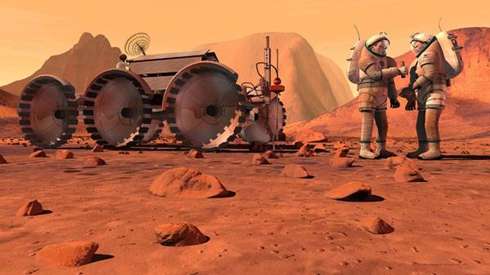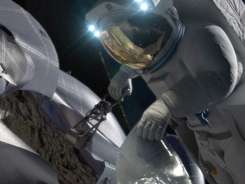NASA suggests humans could be on Mars by 2035

(Phys.org) —At the European Lunar Symposium held at the Museum earlier this month, NASA officials revealed that the Moon could be used as a practice ground for sending humans to Mars within 20 years.
NASA's chief scientist Dr Ellen Stofan and deputy chief technologist Jim Adams told the assembled scientists that putting humans on Mars is NASA's 'primary mission'.
While there have been many robotic missions to Mars in search of water and signs of life, including Curiosity's current assignment, Dr Stofan believes it's now essential to send human scientists.
'To unambiguously settle the questions of whether there was life on Mars it will take scientists down on the surface,' Dr Stofan said.
However, she admitted there is still a long way to go to ready the technologies for such a mission.
With the exception of those who went to the Moon, the majority of people sent into space so far have been in 'low Earth orbit', relying on systems on Earth to keep them alive. A journey to Mars would take months.
Bagging an asteroid
Before taking the plunge and attempting to send people to Mars, and the associated dangers of deep space, NASA plans to use the Moon as an intermediate proving ground, because it is close enough to return astronauts home within a couple of days.

But rather than landing on the lunar surface, the plan is to pull an asteroid close enough to the Moon to allow astronauts to take samples from it.
The Asteroid Redirect Mission aims to find a small asteroid travelling between the Moon and Earth and to 'snag it, bag it and drag it' into orbit around the Moon where it can be reached by astronauts.
Hazardous journey
Robots would perform the capture portion, testing ion propulsion systems - the heavy-duty thrusters that would be needed to get humans and their equipment all the way to Mars.
The budget for seeking out near-Earth objects such as asteroids has already been doubled to find a suitable candidate for the mission.
The human phase would then test new suits designed to protect astronauts from health hazards such as bursts of solar wind. It would also train astronauts in protocols for working in deep space, far from home.
'We're working to reduce the risks so that people can arrive on Mars happy and healthy and ready to work.' Dr Stofan said.
Fly by
To the disappointment of many of the scientists in the audience, who want to see more lunar exploration, Dr Stofan and Adams said that NASA does not intend to use the Moon's surface as part of its journey to Mars. They did acknowledge, however, the general importance of research on the surface, both for science and exploration, and said they will work with partners in other space agencies.
Research on the Moon could help work out how to gather resources from the surface of an alien world, such as how to extract water.
Beyond Mars
Adams finished the talk with tantalising inspiration. 'Where NASA is headed is to the Martian surface in the 2030s,' he said.
'It is my dream that once we've put boots on Mars and we've established that pioneering presence on the surface, we would have already been thinking about where to go next. I hope that you guys will be along for the ride.'
Provided by Natural History Museum




















